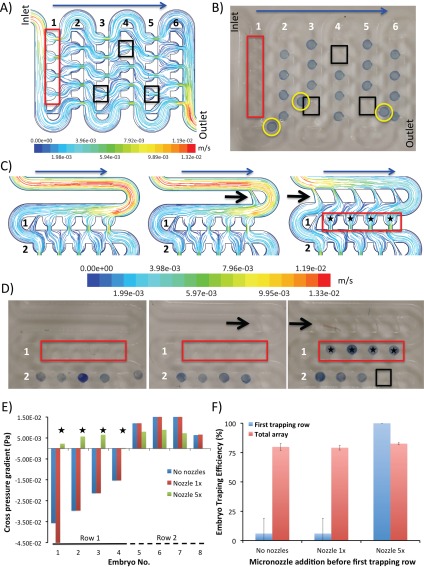Figure 3.
Implementation of diverging channels to improve the trapping efficiency. (a) Streamlines of fluid colored by flow velocity (m/s) across the original prototype at the vertical middle plane when perfused at a flow rate of 1 ml/min. Red and black rectangles highlight the regions of suboptimal trapping efficiency due to the high velocity of fluid within the main channel of the first row and the inadequate suction within the last traps of each row. (b) Experimental validation of conditions shown in (a). Note that a good agreement of experimental embryo docking as compared to the CFD simulations. Red and black rectangles highlight the regions of suboptimal trapping efficiency. Yellow circles highlight the un-trapped embryos travelling in the main channel. (c) Streamlines of fluid colored by flow velocity (m/s) for modified design implementing diverging channels (black arrows). The data are shown for the initial two trapping rows only. Note that the addition of the five diverging channels decreases the flow velocity within the main channel considerably while increases the cross flow towards the first four traps. Blue arrows denote the direction of flow, black arrows denote the implementation of diverging channels and black stars refer to the regions with improved trapping efficiency. Note that the implementation of diverging channels in the first channel help slow the flow velocity and redirect more flow towards the traps. (d) Experimental validation of improved trapping due to diverging channels. Note that 100% trapping achieved in the first row following the implementation of five diverging channels. Black arrows denote the implementation of diverging channels and black stars refer to the regions with improved trapping efficiency. (e) Variations of cross pressure gradient at different traps of the designs with 0, 1×, and 5× diverging channels, as obtained by the pressure balance model. Note the excellent agreement between CFD simulations and experimental data as shown in (d). Improvement (traps 1–4) and deterioration (trap 8) of the embryo docking following the implementation of diverging channels is clearly visible. (f) Comparative representation of results from embryo docking experiments performed at a volumetric flow rate of 1 ml/min. Note that localized improvement in trapping efficiency following the implementation of new geometry does not necessarily translate into the improvements across the whole array.

